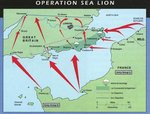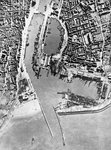Njaco
The Pop-Tart Whisperer
While researching some things for the "Battle of Britain" thread, I found a few things of interest about Operation Sea Lion including an OOB for the German forces. Also a map for Heeresgruppe A's objectves for the invasion.
I posted just one part of the .pdf file and a few pics that I found.......
Operation "Seelöwe" (Sea Lion) Order of Battle, mid-September 1940
Army Group A
Commander-in-Chief: Generalfeldmarschall Gerd von Rundstedt
Chief of the General Staff: General der Infanterie Georg von Sodenstern
Operations Officer (Ia): Oberst Günther Blumentritt
16th Army
Commander-in-Chief: Generaloberst Ernst Busch
Chief of the General Staff: Generalleutnant Walter Model
Operations Officer (Ia): Oberst Hans Boeckh-Behrens
Luftwaffe Commander (Koluft) 16th Army: Oberst Dr. med. dent. Walter Gnamm
Division Command z.b.V. 454: Charakter als Generalleutnant Rudolf Krantz (This staff
served as the 16th Army's Heimatstab or Home Staff Unit, which managed the assembly
and loading of all troops, equipment and supplies; provided command and logistical
support for all forces still on the Continent; and the reception and further transport of
wounded and prisoners of war as well as damaged equipment. General der Infanterie
Albrecht Schubert's XXIII Army Corps served as the 16th Army's Befehlsstelle Festland or
Mainland Command, which reported to the staff of Generalleutnant Krantz. The corps
maintained traffic control units and loading staffs at Calais, Dunkirk, Ostend, Antwerp
and Rotterdam.)
FIRST WAVE
XIII Army Corps: General der Panzertruppe Heinric h-Gottfried von Vietinghoff genannt
Scheel (First-wave landings on English coast between Folkestone and New Romney) –
Luftwaffe II./Flak-Regiment 14 attached to corps
• 17th Infantry Division: Generalleutnant Herbert Loch
• 35th Infantry Division: Generalleutnant Hans Wolfgang Reinhard
VII Army Corps: Generaloberst Eugen Ritter von Schobert (First-wave landings on
English coast between Rye and Hastings) – Luftwaffe I./Flak-Regiment 26 attached to
corps
• 1st Mountain Division: Generalleutnant Ludwig Kübler
• 7th Infantry Division: Generalleutnant Eccard Freiherr von Gablenz
SECOND WAVE
V Army Corps: General der Infanterie Richard Ruoff (Transferred from the first to the
second wave in early September 1940 so that the second echelons of the two first-wave
corps could cross simultaneously with their first echelons)
• 12th Infantry Division: Generalmajor Walter von Seydlitz-Kurzbach
• 30th Infantry Division: General der Infanterie Kurt von Briesen
XXXXI Army Corps: General der Panzertruppe Georg-Hans Reinhardt
• 8th Panzer Division: Generalleutnant Adolf Kuntzen – Luftwaffe Light Flak-Abteilung 94
attached to division
• 10th Panzer Division: Generalleutnant Ferdinand Schaal – Luftwaffe Light Flak-
Abteilung 71 attached to division
• 29th Infantry Division (Motorized): Generalmajor Walter von Boltenstern – Luftwaffe
Light Flak-Abteilung 76 attached to division
• Infantry Regiment "Großdeutschland": Oberst Wilhelm- Hunold von Stockhausen
• Leibstandarte SS Adolf Hitler Regiment: SS-Obergruppenführer Josef "Sepp" Dietrich
THIRD WAVE
IV Army Corps: General der Infanterie Viktor von Schwedler
• 24th Infantry Division: Generalmajor Hans von Tettau
• 58th Infantry Division: Generalmajor Iwan Heunert
XXXXII Army Corps: General der Pionere Walter Kuntze
• 45th Infantry Division: Generalleutnant Friedrich Materna
• 164th Infantry Division: Generalmajor Josef Folttmann
I posted just one part of the .pdf file and a few pics that I found.......
Operation "Seelöwe" (Sea Lion) Order of Battle, mid-September 1940
Army Group A
Commander-in-Chief: Generalfeldmarschall Gerd von Rundstedt
Chief of the General Staff: General der Infanterie Georg von Sodenstern
Operations Officer (Ia): Oberst Günther Blumentritt
16th Army
Commander-in-Chief: Generaloberst Ernst Busch
Chief of the General Staff: Generalleutnant Walter Model
Operations Officer (Ia): Oberst Hans Boeckh-Behrens
Luftwaffe Commander (Koluft) 16th Army: Oberst Dr. med. dent. Walter Gnamm
Division Command z.b.V. 454: Charakter als Generalleutnant Rudolf Krantz (This staff
served as the 16th Army's Heimatstab or Home Staff Unit, which managed the assembly
and loading of all troops, equipment and supplies; provided command and logistical
support for all forces still on the Continent; and the reception and further transport of
wounded and prisoners of war as well as damaged equipment. General der Infanterie
Albrecht Schubert's XXIII Army Corps served as the 16th Army's Befehlsstelle Festland or
Mainland Command, which reported to the staff of Generalleutnant Krantz. The corps
maintained traffic control units and loading staffs at Calais, Dunkirk, Ostend, Antwerp
and Rotterdam.)
FIRST WAVE
XIII Army Corps: General der Panzertruppe Heinric h-Gottfried von Vietinghoff genannt
Scheel (First-wave landings on English coast between Folkestone and New Romney) –
Luftwaffe II./Flak-Regiment 14 attached to corps
• 17th Infantry Division: Generalleutnant Herbert Loch
• 35th Infantry Division: Generalleutnant Hans Wolfgang Reinhard
VII Army Corps: Generaloberst Eugen Ritter von Schobert (First-wave landings on
English coast between Rye and Hastings) – Luftwaffe I./Flak-Regiment 26 attached to
corps
• 1st Mountain Division: Generalleutnant Ludwig Kübler
• 7th Infantry Division: Generalleutnant Eccard Freiherr von Gablenz
SECOND WAVE
V Army Corps: General der Infanterie Richard Ruoff (Transferred from the first to the
second wave in early September 1940 so that the second echelons of the two first-wave
corps could cross simultaneously with their first echelons)
• 12th Infantry Division: Generalmajor Walter von Seydlitz-Kurzbach
• 30th Infantry Division: General der Infanterie Kurt von Briesen
XXXXI Army Corps: General der Panzertruppe Georg-Hans Reinhardt
• 8th Panzer Division: Generalleutnant Adolf Kuntzen – Luftwaffe Light Flak-Abteilung 94
attached to division
• 10th Panzer Division: Generalleutnant Ferdinand Schaal – Luftwaffe Light Flak-
Abteilung 71 attached to division
• 29th Infantry Division (Motorized): Generalmajor Walter von Boltenstern – Luftwaffe
Light Flak-Abteilung 76 attached to division
• Infantry Regiment "Großdeutschland": Oberst Wilhelm- Hunold von Stockhausen
• Leibstandarte SS Adolf Hitler Regiment: SS-Obergruppenführer Josef "Sepp" Dietrich
THIRD WAVE
IV Army Corps: General der Infanterie Viktor von Schwedler
• 24th Infantry Division: Generalmajor Hans von Tettau
• 58th Infantry Division: Generalmajor Iwan Heunert
XXXXII Army Corps: General der Pionere Walter Kuntze
• 45th Infantry Division: Generalleutnant Friedrich Materna
• 164th Infantry Division: Generalmajor Josef Folttmann



